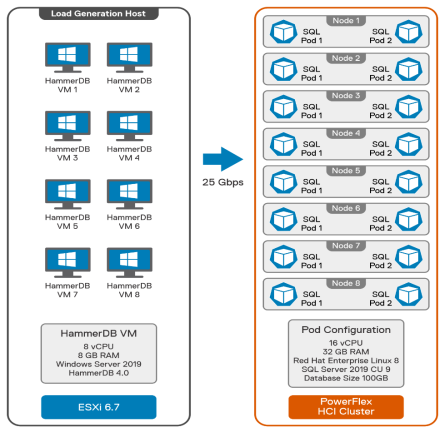Home > Storage > PowerFlex > White Papers > Architecting Microsoft SQL Server 2019 Containers on Dell EMC PowerFlex > Test methodology
Test methodology
-
You can validate the performance of SQL Server 2019 on a containerized environment by simulating an OLTP workload with the HammerDB tool. An OLTP workload typically runs a specific set of read and write queries against the database that are known as database transactions, which are measured as transactions per minute (TPM).
For this reference architecture, a sample database is populated with 100 GB of data on each SQL pod and multiple virtual user tests are run for frequent interval of time against each pod to get optimal TPM numbers. For information about the lab setup, see Logical architecture.
HammerDB is installed on a dedicated VM, and the load is generated in a client/server model, as shown in the following figure. These VMs are hosted on dedicated ESXi hosts and not on the worker nodes. Worker nodes are dedicated for hosting the SQL Server pods.

Figure 15. HammerDB load testing
Each VM is running two HammerDB instances pointing to two SQL Server pods. Typically, each HammerDB VM is pointing to one worker node generating load for two SQL Server pods hosted on the node. A dedicated 25 G connection is used between the ESXi host and the worker nodes for the client network. You can perform multiple runs by simulating the number of virtual users against the sample database that is populated on all the pods.
